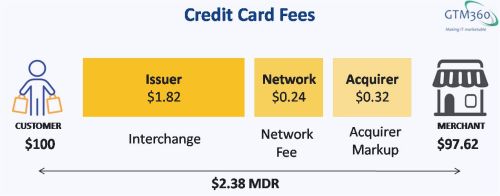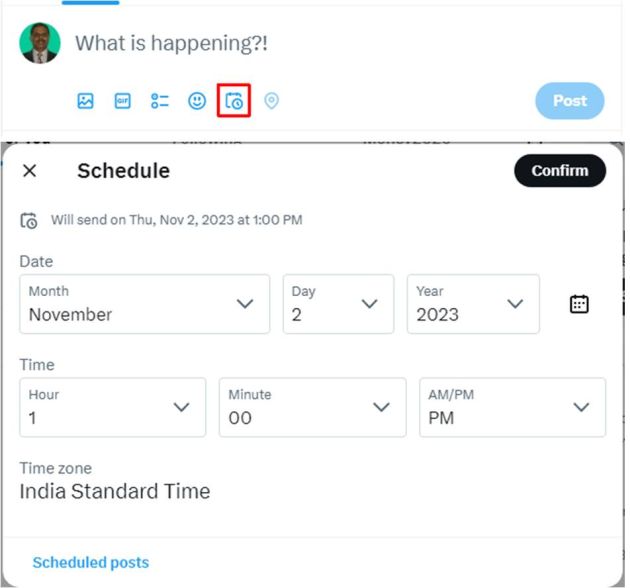This post provides a quick primer on MDR, Interchange, and Surcharge, and covers a few recent updates to rules around these key concepts in the credit card industry.
Merchant Discount Rate (MDR)
When you buy something worth $100 and pay with a credit card, the merchant gets $97.62.
The difference of $2.38 is the fees paid by the merchant for using the credit card network to receive payments. It’s called Merchant Discount Rate (MDR) or Merchant Service Charge (MSC). Spec’ced by the card networks (e.g. Visa, MasterCard), MDR varies from one class of credit card to another and across different merchandise types but averages 2.38%.
Interchange
While MDR and Interchange are related, they’re not the same:
MDR = Interchange + Network Fee + Acquirer Markup.
Because Visa, MasterCard, and other card networks set interchange rates for their respective networks, the common man – and some self-styled experts – think that they receive the interchange revenue. That’s not true. Interchange goes to the Issuer Bank (the bank that has issued the credit card to the consumer), which then distributes a small portion of it as network fee to the Card Network and acquirer markup to the Acquirer Bank (the bank that issues the merchant account / POS terminal to the merchant and thereby enables it to accept credit card payments).
This is easy to verify: The Total Payments Value of Visa credit card transactions was $8 trillion last year. 2% interchange on that TPV works out to $160B. Visa’s revenue was $30B.
@s_ketharaman: PSA for Faux Patriots: Visa / MasterCard don’t earn ?2 on every ?100 credit card transaction in India. They earn only ?0.25. The other ?1.75 is earned by banks in India who pay tax due on it to Indian govt, India benefits. OTOH, banks in India make ?0 on a typical ?100 UPI payment, pay no tax, nation does not benefit, on the contrary government pays subsidy from taxpayer money to banks to compensate them for processing UPI payments without charging any MDR.
In the above example, out of the $2.38 MDR, issuer bank gets $1.82 (Interchange), card network gets $0.24 (Network Fee), and acquirer bank gets $0.32 (Acquirer Markup) to the acquirer bank. This is illustrated in the following exhibit of the credit card value chain:
Why MDR Is Ad Valorem
Since the technology for processing credit card has a fixed cost, the J6P (Joe Six Pack) wonders why banks charge an ad valorem fees of 2.38% instead of a flat fee that’s independent of the sale value.
To grasp this apparent disconnect, it’s necessary to go beyond technology and understand the product concept of credit card.
Everybody knows that credit card provides credit to the cardholder (that carries zero interest cost if the cardholder pays off the full balance by the end of the month).
However, what is not widely known is that credit card is a credit product even from the POV of the merchant. Banks pay the full sale value (less MDR) to merchants within 1-2 days of the sale even though they collect their money from the cardholder only after 20-50 days of the sale. In other words, banks give a loan to the merchant in a credit card transaction. The cost of credit is interest. Since interest is always a percentage of the loaned amount, MDR is ad valorem and not a flat fee.
Honor All Codes Rule
If a merchant chooses to accept Visa cards for payment, then, according to the “Honor All Cards” rule, they must accept all valid Visa-branded cards. In other words, merchants are not allowed to accept some Visa cards while declining others based on card type or issuing bank. This anti-discrimination rule is designed to ensure that Visa cardholders have consistent and fair access to their payment method at all participating merchants. (H/T ChatGPT)
Surcharge
Let’s say a consumer visits a store, picks up a product from the shelf with a sticker price of $100, and comes to checkout.
When she pays with cash, she pays $100.
If she takes out a credit card, the clerk asks for $105. The $5 is called Surcharge. Surcharge is ad valorem. The merchant receives $102.62 net (being $100 Sale Value – $2.38 MDR + $5 Surcharge).
As you can see, MDR is $2.38 whereas Surcharge is $5 i.e. Surcharge exceeds MDR.
The most egregious case of surcharge exceeding MDR that I’ve come across is Qantas. When I last checked, the flagship carrier of Australia levied 7.5% surcharge for air ticket bookings with credit card. (I’ve seen higher prices of as much as 20% for tickets booked online at BookMyShow but I’m not clear about whether Convenience Charge, as BMS calls this excess cost, can be termed as Surcharge in the credit card industry parlance.)
(The Latin term “ad valorem” means according to value. It can be part of basic amount à la MDR or in addition to basic amount à la Surcharge.)
No Surcharge Rule
According to the No Surcharge rule, merchants cannot penalize credit card users by charging them more than the sticker price. In other words, if the above consumer pays with credit card, the merchant cannot demand more than $100.
Contrary to what many people believe, the No Surcharge rule does not stop the merchant from giving a cash discount to incentivize cash payments. In the above example, the merchant can sweeten cash purchase by taking only $96. (It’s another story that I’ve not come across a single merchant who gives a discount for payments made with cash – or UPI or debit card).
During the last 10 years or so, the No Surcharge rule has been repealed in many jurisdictions, so merchants can legitimately charge more than the sticker price if the customer pays with credit card.
Credit Card Surcharge Update in USA:
* Banned only in 7 states
* Max 4%
* Discount on cash allowed incl. debit card
* Convenience Charge is separate and must be a flat fee, no matter the purchase amounthttps://t.co/qs7EwIIleS via @DTPaymentNews— Ketharaman Swaminathan (@s_ketharaman) October 4, 2018
Cap on Surcharge
As we saw earlier, Surcharge ? MDR and it’s often higher than MDR. Over time, as we saw above, many merchants abused the ability to surcharge, so there are new laws that cap surcharge e.g. In New Jersey, and a couple of other states in USA, Surcharge cannot exceed MDR.
Where this rule is in force, the merchant in the above example cannot charge more than $102.38 for credit card purchases (goodbye $105).
New Jersey Passes Credit Card Surcharge Bill ~ https://t.co/OtIoFc1OeA via @PaymentsDive .
MDR = Surcharge in NJ. But, in general, they need not be equal. MDR is what Bank charges Merchant and Surcharge is what Merchant charges Customer.— GTM360 (@GTM360) August 1, 2023
The above figures – normalized to Visa’s credit card ticket size of $63.00 – are depicted in the following exhibit, which also shows the workflow of a credit card transaction.
Before closing, it’s worth mentioning that, while MDR and other terms described above originated in the credit card industry, they have also been coopted subsequently by other retail payment methods like A2A RTP (e.g. UPI in India, FPS in UK, Zelle in USA, Pix in Brazil).
As of now, MDR for UPI – and almost all other major A2A RTPs in the world – is zero if the transaction is funded from a bank account (as is default), 2% if the funding source is credit card and >1.1% if it is PPI (both of which are supported on UPI).
UPI MDR is zero only on "normal UPI" i.e. where funding source is bank account. MDR for "UPI via RuPay Credit Card" is 2%. Not sure about MDR but Interchange for "UPI via PPI" is 1.1%.
— Ketharaman Swaminathan (@s_ketharaman) May 4, 2023



